 |
 |
 |
|
|
 |
Annual Service Plan Report Appendices — Continued
Appendix 2: Performance Reporting Definitions, Rationales and
Trends
The following measures that appear in this document are not included
in the 2003/04 – 2005/06 Service Plan. These changes
reflect the ministry's efforts to improve its public reporting
by focusing on fewer, more meaningful measures and by avoiding
redundancy.
| 1.1 |
(a) |
Progress towards implementing a new model
for governance and delivery of adult community living services |
| 1.1 |
(b)
| Percentage reduction in the unit cost of
residential CLS service |
| 1.1 |
(c) |
Number of adults with developmental disabilities
receiving services |
| 1.1 |
(d) |
Client satisfaction measure to be developed |
| 1.2 |
(a) |
Percentage of CLS clients who are living
with family and receiving ministry services |
| 1.2 |
(b) |
Percentage of CLS clients living in semi-independent
living and family care settings |
| 2.1 |
(a) |
Number of youth forensic psychiatric assessments
completed |
| 2.1 |
(b) |
Number of youth forensic treatment services |
| 2.1 |
(d) |
Number of family group conferences |
| 2.2 |
(a) |
Number of Youth Agreements that are active
at the end of the year |
| 2.3 |
(b) |
Progress on the development of a Child and
Youth Mental Health Plan |
| 3.1 |
(a) |
The proportion of kindergarten aged children
who are "ready to learn" |
| 3.1 |
(b) |
Number of learning sites to foster the integrated
planning and delivery of early childhood developmental initiatives |
| 3.2 |
(a) |
Rate of children in care with special needs
that are in the care of the ministry (per 1,000 children with
identified special needs) |
| 3.2 |
(b) |
Percentage of children in care through Special
Needs Agreements |
| 4.1 |
(b) |
Rate of reoccurrence of maltreatment |
| 4.1 |
(c) |
The percentage of Aboriginal agencies serving
Aboriginal children in care |
| 4.2 |
(a) |
Percentage of children in residential care
placed in foster homes instead of other contracted residential
resources (excludes delegated Aboriginal children) |
| 5.1 |
(a) |
Progress towards implementing community-based
governance structures |
| 5.2 |
(b) |
Implementation status of administrative
plans |
| 5.2 |
(c) |
Implementation of streamlining of administration |
| Measure:
Progress towards implementing a new model for governance and
delivery of adult community living services |
| Definition
This is a qualitative process measure and may include any
activity that the ministry or Interim Authority undertook
in fiscal 2002/03 in order to establish community-governance
for community living services.
|
| Rationale
The new governance system will deliver services in a more
flexible and effective manner than past governance structures.
Therefore, the establishment of this governance model is an
essential component of achieving the stated goal and objectives.
|
| Measure:
Percentage reduction in the unit cost of residential CLS service |
| Definition
The actual expenditures for residential adult community
living services, divided by the number of open case files
in adult community living (based on March 2003 figures and
reports).
|
| Rationale
A reduction in the average cost per residential CLS client
is essential to ensuring the sustainability of community
living services. It also reflect a movement towards more
family-based residential services.
|
| Comments
This measure has been amended to reflect the unit cost
of residential CLS services. The baseline has been updated
to reflect this change.
|
Trends
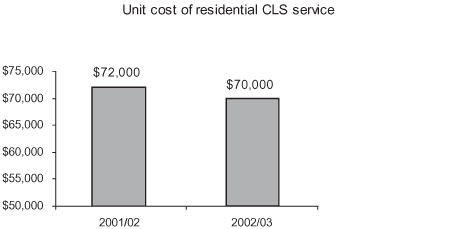
| Measure:
Number of adults with developmental disabilities receiving services |
| Definition
The number of open case files in March 2003. This is a
proxy for the number of clients receiving services; however,
there may be some discrepancy due to files that need to
be closed, or files for which services have not yet commenced.
|
| Rationale
Illustrates the ministry's commitment to continuing to
provide services to adults with developmental disabilities.
|
| Comments
In the 2002/03 – 2004/05 Service Plan, this measure
was shown as a fiscal average, but was subsequently changed
to a point-in-time measure in the 2001/02 Annual Report,
to more accurately reflect workload. The baseline has been
amended to reflect this change.
|
Trends
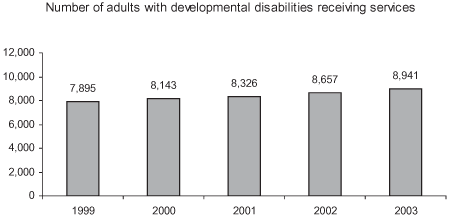
| Measure:
Client satisfaction measure to be developed |
| Definition
This measure was not developed since the requirements of
accreditation will address this area. As part of the move
to community governance, all Authorities — including
ICLBC — will be required to become accredited with
one of two accrediting bodies approved by the Minister.
In order to meet the accreditation requirements, all Authorities
will need to develop and implement a method of tracking
client satisfaction.
|
| Rationale
N/A
|
| Trends
N/A
|
| Measure:
Percentage of CLS clients who are
living with family and receiving ministry services |
| Definition
Number of adults with developmental delays receiving MCFD-funded
services excluding residential care, divided by the total
number of CLS clients. Data based on March 2003 figures.
|
| Rationale
Illustrates the ministry's commitment to building the capacity
of families and communities to support adults with developmental
disabilities.
|
Trends
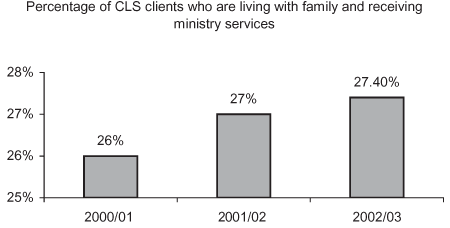
| Measure:
Percentage of adult CLS clients living in semi-independent living
and family care settings |
| Definition
The number of clients coded as living in semi-independent
and family care settings divided by the total number of
community living clients. Figures are based on March 2003
data.
|
| Rationale
Shows the ministry's commitment to providing supports to
maintain adults with developmental disabilities while living
in a more independent environment.
|
| Trends
2000/01 — 17%
2001/02 — 17%
2002/03 — 17%
|
| Measure:
Number of families receiving CLS individualized funding supports |
| Definition
The number of adult community living clients that receive
some form of individualized funding through MCFD under a
CLS service.
Note: A family may receive individualized funding
from more than one source, so some families may be counted
more than once.
|
| Rationale
Individualized funding is a method of increasing choice
for the families and clients receiving community living
services.
|
| Trends
N/A
|
| Comments
In fiscal 2002/03, MCFD developed a program of individualized
funding for children 0–6 with autism.
|
| Measure:
Number of youth forensic psychiatric assessment services |
| Definition
The number of youth psychiatric assessment services during
the fiscal year for youth aged 12–17. This includes
all new assessment services, as well as any assessment service
that was initiated, but not completed, prior to the beginning
of the fiscal year.
Note: The number of assessment services is
not the same as the number of youth receiving assessment
services, since a youth may receive more than one assessment
service.
|
| Rationale
Measures the effectiveness of the ministry in continuing
to deliver services to assist in the rehabilitation of youth
in the justice system.
|
| Comments
The number of youth forensic assessment services has been
revised since the 2001/02 Annual Report. The baseline has
been adjusted from 1,277 for 2001/02 (to 1,600) to reflect
a more accurate method of counting assessment services in
order to more accurately reflect workload.
|
Trends
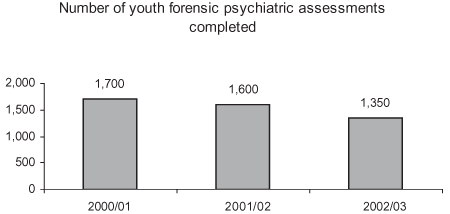
| Measure:
Number of youth forensic treatment services |
| Definition
The number of treatment services during the fiscal year.
This includes all new treatment services, as well as any
treatment service that was initiated, but not completed,
prior to the beginning of the fiscal year.
Note: The number of treatment services is not the
same as the number of youth receiving treatment services,
since a youth may receive more than one treatment service.
|
| Rationale
Measures the effectiveness of the ministry in continuing
to deliver services to assist in the rehabilitation of youth
in the justice system.
|
| Comments
The number of youth forensic treatment services has been
revised since the 2001/02 Annual Report. The baseline has
been adjusted, from 2,326 for 2001/02 to 2,050, to reflect
a more accurate method of counting assessment services in
order to more accurately reflect workload.
|
Trends
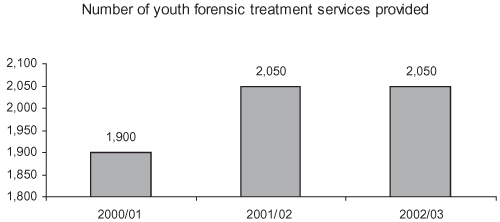
| Measure:
Rate of youth in custody based on a proportion of all 12–17
year olds (per 10,000) |
| Definition
The number of youth in custody under the Youth Criminal
Justice Act expressed as a ratio of the total population
of youth to which the Youth Criminal Justice Act
applies (12–17 years).
|
| Rationale
This is a measure of the extent to which community-based
programs act as an effective alternative to custody.
|
Trends
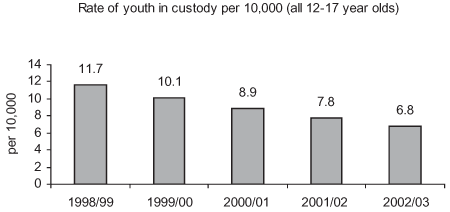
| Measure:
Number of family group conferences |
| Definition
The number of family group conferences conducted under
a pilot program in Youth Justice in 2001/02.
|
| Rationale
This measure shows the ministry's commitment to developing
and implementing alternatives to youth custody.
|
| Comments
The family group conferencing program was being piloted
from the Burnaby Youth Court, which was closed during 2001/02.
This explains the low number of family group conferences
that took place.
|
| Measure:
Number of Youth Agreements that are active at the end of the
fiscal year |
| Definition
The number of Youth Agreements that are active on March
31. A Youth Agreement is a comprehensive, non-guardianship
service plan contracted between the ministry and a 16–18
year old youth in need of assistance and at high risk for
such issues as sexual exploitation, homelessness, street
entrenchment, drug addiction and mental health, with a goal
towards successful transition to independence and/or return
to family.
|
| Rationale
A measure of the extent that the ministry is using alternatives
to government care for youth and to meet the needs of at-risk
youth.
|
| Trends
2000/01 — 161
2001/02 — 141
2002/03 — 161
|
| Measure:
Number of children and youth receiving community child and youth
mental health services |
| Definition
Number of children and youth receiving community child
and youth mental health services through ministry-staffed
mental health service providers. Number does not indicate
the type or frequency of service.
|
| Rationale
Illustrates the ministry's commitment to delivering child
and youth mental health services in a community-based setting.
|
| Trends
2000/01 — 10,400
2001/02 — 10,400
2002/03 — 10,400
|
| Comments
This number does not reflect services that are delivered
through contracted resources.
|
| Measure:
Progress on the development of a Child and Youth Mental Health
Plan |
| Definition
This is a process measure and reflects the progress to
date on the development and implementation of the provincial
Child and Youth Mental Health Plan.
|
| Rationale
The Child and Youth Mental Health Plan will enhance child
and youth mental health services in British Columbia.
|
| Measure:
The proportion of kindergarten aged children who are "ready
to learn" |
| Definition
Learning Sites are communities that receive funding for
the purpose of contributing to the determination of an integrated
and comprehensive system for early childhood development
that can be applied provincially.
|
| Rationale
This measure illustrates both the ministry's commitment
to promoting early childhood development as a strategic
investment and its commitment to build on the capacity of
communities to plan and deliver appropriate services.
|
| Measure:
Number of learning sites to foster the integrated planning and
delivery of early childhood development initiatives |
| Definition
Learning Sites are those that receive funding for the purpose
of contributing to the determination of an integrated and
comprehensive system for early childhood development that
can be applied provincially.
|
| Rationale
This measure illustrates both the ministry's commitment
to promoting early childhood development as a strategic
investment and its commitment to build the capacity of communities
to plan and deliver appropriate services.
|
| Measure:
Number of communities with urban Aboriginal early childhood
development programs |
| Definition
The number of communities are defined as the number of
urban centres (i.e., Terrace, Kamloops, City of Vancouver)
that have an approved proposal for Aboriginal early childhood
development funding. There may be more than one proposal
per urban centre.
|
| Rationale
This measure demonstrates the ministry's support of building
capacity within Aboriginal communities.
|
| Measure:
Rate of children with special needs that are in the care of
the ministry (per 1,000 children with identified special needs) |
| Definition
The number of children in care with special needs (as of
March each fiscal year) as a proportion of total estimated
B.C. children with special needs. Child in care with special
needs is defined as any child in care who has a Special
Needs Agreement; is in the Community Living Services service
stream; or is identified as having a health/behaviour indicator
of any one of the following: autism, fetal alcohol spectrum
disorder, neo-natal abstinence syndrome, developmental disability/delay,
mental health-diagnosed condition, dual diagnosis, physical
health-communication deficit, medical condition, physical
disability, procedural/equipment requirement, other developmental
disability.
Population of children with special needs for 2001/02 is
estimated at 52,450 (prevalence rate of 5.6%).
|
| Rationale
This measure is an indicator of the ministry's effectiveness
in promoting and enhancing the capacity of families with
children with special needs in caring for their children.
|
| Trends
March 2001 — 111/1,000
March 2002 — 114/1,000
March 2003 — 108/1,000
|
| Comments
The baseline for this measure has been updated since the
2001/02 Annual Report. The previous baseline of 119/1,000
(2000/01) has been updated to 111/1,000 in order to reflect
a more accurate method of counting children in care with
special needs.
|
| Measure:
Percentage of children in care through Special Needs Agreements |
| Definition
Number of children in care with special needs, through
Special Needs Agreements under the Child, Family and
Community Service Act as a proportion of total children
in care with special needs, as of March each year.
A Special Needs Agreement is a voluntary agreement made
between the ministry and a child's parent. This agreement
allows the ministry to care for a child who requires specialized
support when the parent is unable to meet these needs at
home.
|
| Rationale
This measure is an indicator of the ministry's effectiveness
in promoting and enhancing the capacity of families with
special needs in caring for their children.
|
| Trends
March 2001 — 5.3%
March 2002 — 5.3%
March 2003 — 5.5%
|
| Comments
The baseline for this measure has been updated since the
2001/02 Annual Report. The previous baseline of 8.6% (2000/01)
has been updated to 5.3% in order to reflect a more accurate
method of counting children in care through Special Needs
Agreements.
|
| Measure:
Rate of children in care (per 1,000 children under 19 years
of age) |
| Definition
Total number of children in care (as of March each fiscal
year end) divided by all children under 19 years of
age in B.C.
|
| Rationale
Families have the right and primary responsibility to protect
and support the growth and development of children and youth.
Therefore, one of the ministry's goals is to support, strengthen
and develop family capacity, and to reduce the number of
children in the care of the ministry.
|
Trends
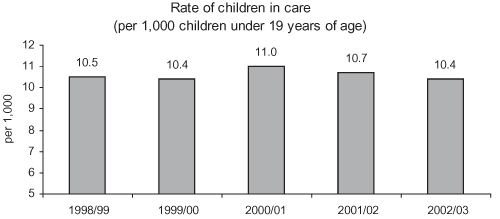
| Measure:
Rate of reoccurrence of maltreatment |
| Definition
The percentage of families who were investigated for a
child protection issue in two consecutive years.
|
| Rationale
The reoccurrence of maltreatment is an indicator of the
effectiveness of family development services and interventions
in enhancing a family's capacity to care for its children
after the ministry has previously intervened.
|
Trends
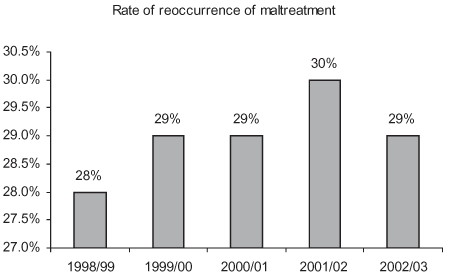
| Measure:
The percentage of Aboriginal agencies serving Aboriginal children
in care |
| Definition
N/A — measure not fully developed
|
| Rationale
N/A — measure not fully developed
|
| Trends
N/A — measure not fully developed
|
| Comments
This measure was not fully developed and implemented since
it is not included in the 2003/04 – 2005/06
Service Plan and is better addressed through "Percentage
of Aboriginal children in care served by Aboriginal
agencies".
|
| Measure:
Percentage of children in residential care placed in foster
homes instead of other contracted residential resources (excludes
delegated Aboriginal children) |
| Definition
The number of children in foster homes for March 2003,
divided by the total number of children in residential care
for March 2003.
|
| Rationale
Placing a child in care in foster care (as opposed to other
contracted resources) usually offers a more suitable environment
for the child.
|
| Trends
March 1999 — 70%
March 2000 — 70%
March 2001 — 73%
March 2002 — 74%
March 2003 — 78%
|
| Measure:
Number of children in care adopted per fiscal year |
| Definition
Total number of children placed with adoptive families.
|
| Rationale
Permanency for children in care is important since it provides
children with a stable and loving family within which to
grow and learn.
|
Trends
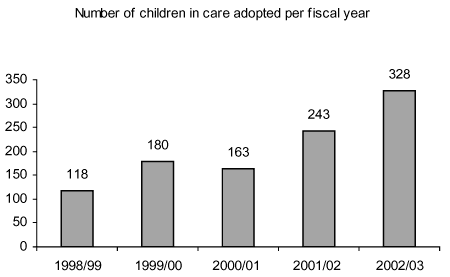
| Measure:
Percentage of Aboriginal children in care served by Aboriginal
agencies |
| Definition
The total number of Aboriginal children in care that are
served by Aboriginal agencies, expressed as a percentage
of Aboriginal children in care.
|
| Rationale
This measure reflects the ministry's commitment to building
the capacity of Aboriginal communities to develop and deliver
services for Aboriginal children and families.
|
| Measure:
Progress towards implementing community-based governance structures |
| Definition
This is a process measure that reflects actual progress
made as of March 2003.
|
| Rationale
The move towards community-based governance and service
delivery will allow for the delivery of services that are
better tailored to the clients' needs.
|
| Measure:
Reduce ministry's regulatory burden by 40% by end of fiscal
2004/05 |
| Definition
"Regulatory Requirement" includes a compulsion, obligation,
demand or prohibition placed on an individual, entity or
activity in ministry legislation, regulation or policy.
|
| Rationale
The government has committed to reducing the regulatory
burden in the province by 33% by 2004/05.
|
| Trends
June 2001 — Baseline (16,963 regulations)
March 2003 — 26.5% reduction (12,453 regulations)
|
| Measure:
Implementation status of administrative plans |
| Definition
N/A — measure not fully developed
|
| Rationale
N/A — measure not fully developed
|
| Trends
N/A — measure not fully developed
|
| Comments
This measure was not fully developed since it was removed
from the 2003/04 – 2005/06 Service Plan. The information
in this measure is better captured in the Summary Reports
section of the 2002/03 – 2004/05 Annual Service Plan
Report.
|
| Measure:
Implementation of streamlining of administration |
| Definition
This is a process measure that reflects actual progress
made as of March 2003.
|
| Rationale
Reducing and streamlining the ministry's administration
will help to focus limited resources on direct services
to children and families.
|
| Trends
N/A
|
|
|
|
|
 |
 |
 |
 |
 |
 |
 |
 |
|
